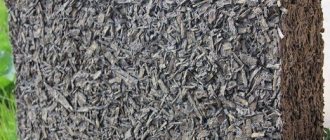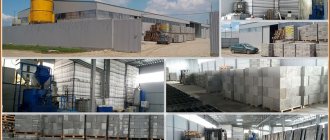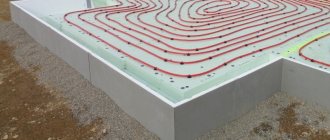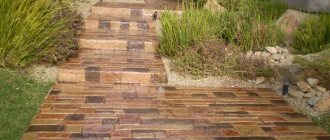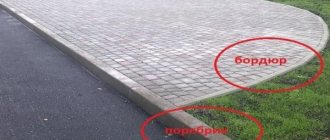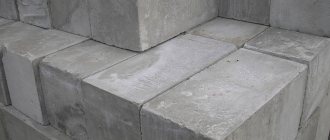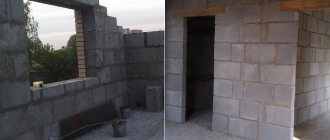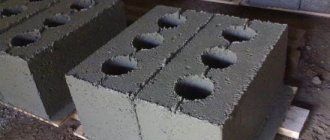Characteristics of raw materials
The building material is classified as a type of lightweight coarse-cell concrete. Wood residues are used as a filler in raw materials. Lumber is joined together with cement into a strong monolithic structure. According to GOST, blocks are produced solid and hollow, for insulation or construction of structures.
Construction material on a pallet Source surgut.blockexpert.ru
The characteristics of construction raw materials depend on the components that are added to the composition. The main ingredients fall into 5 categories:
- Wood. Chips or shavings increase the heat and sound insulation properties of sawdust blocks and make the raw material light.
- Cement. The material improves the wear resistance of the product. According to the technology, the M400 brand is used.
- Sand. Strengthens the strength of construction materials. The proportions of the substance affect the parameters of thermal insulation and hardness.
- Additives to change characteristics. Used to protect against fire, rotting and parasites (rodents, insects).
- Water. Liquid free of foreign particles is added to create a homogeneous solution.
The finished material resembles natural wood in terms of vapor permeability and sound insulation, and foam concrete in strength. Wood residues from the sawmill are used in production. The sustainability of raw materials is not tied to the size or shape of the original waste, what is more important is the uniformity of the structure. When creating, both wood chips and sawdust or flour are used.
The quality of the finished material does not depend on the type of wood. Inexpensive spruce and pine species are popular in production. The antiseptic properties of the resin reduce rotting processes in the blocks, so less chemicals are added to the composition. Birch, poplar and oak have proven themselves well.
Cement is used as a binder. Wood filler contains sugar, which reduces adhesion to liquid concrete. Before manufacturing, the raw materials are pre-soaked in special solutions. For mineralization, calcium chloride or liquid glass, clay or milk of lime are used.
Lightweight, strong material Source poradu24.com
The density of building materials varies from 350 to 850 kg/m2. The shape and size often depend on the tasks that the product must perform. For the construction of structures, blocks of sawdust and cement with parameters 60*40*20 cm are used. Both traditional bricks and slabs are suitable for insulation.
Making blocks yourself
When starting to create blocks from sawdust and cement with your own hands, you need to thoroughly study the entire process and take into account the nuances.
How to create blocks yourself:
- Prepare all the tools and devices for working with the mixture - concrete mixer, hammer crusher, chipping machine, vibropressing machine, vibrating machine, etc.
- Prepare raw materials - buy at least M400 cement at a hardware store, order clean sand, lime (clay can be used), find a lot of sawdust at the factory (preferably dry, if the region is humid - you also need to stock up on mineralizers for processing sawdust, which can be liquid glass or milk of lime).
- Thorough chopping of wood by loading it into a chipper and then into a hammer crusher (to obtain the same fraction).
- Carefully sifting the wood chips to separate debris, soil, bark, etc.
- Impregnation of wood chips - soaking in a mixture of liquid glass and water in a ratio of 1:7. To speed up the process of mineralization and hardening of the material, you can add a little calcium chloride.
- Treatment with slaked lime – disinfection against pests.
- Mixing - to obtain a standard mixture, take 1 ton of Portland cement, 250 kg of lime and 2.5 tons of sand. The volume of chips is determined separately, based on the required characteristics and type of blocks. Everything is mixed in a concrete mixer.
- Pouring the mixture into molds and installing it on a vibrocompression machine.
- Drying - stretching the film over a container with molds, keeping it indoors for 12 days at a temperature of +15 degrees and above (in the cold, hydration will take place much more slowly). The material can be checked periodically - if it is dry, moisten it with water.
Sawdust and cement blocks are an excellent choice for performing many jobs in the field of renovation and construction of low-rise buildings. With the right choice of high-quality material and compliance with the work technology, creating optimal conditions, sawdust concrete will ensure the reliability, strength and durability of the structure.
Advantages and disadvantages
High thermal insulation qualities are the main positive side of materials made from sawdust and cement. When raw materials are used in construction or insulation, the inside of the building remains warm in winter and pleasantly cool in summer. The porous structure provides excellent vapor permeability. A wall made of blocks 30 cm thick is not inferior in quality to a meter-long brick partition.
Material based on wood residues is durable. When using fiberboard or wood concrete with its characteristics, the building lasts for a very long time. The raw materials are resistant to deformation and shock loads. The cement and sand in the solution allow the structure not to burn for 2 hours at +1200 C.
The material is cheaper in price than foam blocks and bricks. If you make wood concrete yourself, you can save on raw materials. The low weight of the components reduces the load on the foundation, therefore reducing the costs of arrangement during construction.
Sawdust and cement blocks are easy to saw and cut into the desired size without the use of complex professional equipment. You can hammer a dowel into the surface or screw a self-tapping screw. The bulk material is resistant to chipping and cracking.
Wood chips, sawdust or shavings are clean and safe raw materials that rarely cause allergies. Production technology allows you to combine different types of residues. If you make blocks yourself, then the property owner controls the composition of the wood concrete, the proportions and quality of the ingredients.
Pros and cons of the material Source kaknadostroit.ru
The building material has poor moisture resistance. Raw materials made from shavings or wood chips actively absorb liquid, so the surface must be protected. Puttying street and interior partitions will protect the structure from the destructive effects of water. When insulating facades, a drainage system is provided from the roof and the eaves extend at a distance of 50 cm.
Making blocks from sawdust and cement is a long and painstaking procedure. After pouring into the mold, the material should harden within 3-3.5 months. During drying, the components shrink and decrease in size (up to 1%). If you use “immature” raw materials, then drying will be reflected in changes in the parameters of the partitions and the appearance of cracks in the plaster.
Blocks made of sawdust and cement - advantages and disadvantages
Making blocks from sawdust and cement has many advantages compared to heavy materials and other lightweight concrete. Main advantages:
- minimum weight. The lightness of the material ensures savings on the construction and reinforcement of the base. The cost of the foundation based on the calculation calculator sometimes indicates the possibility of reducing the estimate by 30-40%;
- high levels of noise insulation. Due to the presence of voids in the material, it becomes similar to noise-absorbing slabs. The blocks maintain a comfortable sound environment indoors and prevent noise from entering the street;
- increased thermal insulation leads to savings on coolants;
- environmental Safety. The naturalness of the raw materials provides protection against the penetration of toxins, radiation and other harmful fumes;
- ease of processing. The material is relatively soft and easy to cut or separate. The structure remains dense, there is no negative impact after cutting, the material is still intact and durable;
- low price. Sawdust is present in abundance at any woodworking enterprise;
Blocks made of sawdust and cement are an environmentally friendly material
- ease of use. The blocks are relatively large in size, but light. Sawdust concrete walls are built faster;
- durability. Subject to compliance with the manufacturing and construction rules, the building will last from 50 to 80 years.
The presence of wood in the composition should make the material easily flammable, but due to the special production technology, the blocks are resistant to fire. During experimental tests, it was found that a structure made of sawdust concrete can easily withstand being under a fire for 2.5 hours without losing its performance properties. The material can withstand temperatures of 1100°C.
The use of shavings and wood chips leads to some disadvantages:
- Making blocks from cement and sawdust with your own hands requires a lot of time. The production cycle takes up to 3 months from the moment the mold is filled;
- the material absorbs moisture. Additionally, sawdust concrete needs protection from moisture from the outside and inside;
- The composition and characteristics of the sawdust greatly influence the final performance. It is recommended to use only sawdust with a low sugar concentration, as the substance accelerates decomposition and has a destructive effect on the product.
Having assessed the pros and cons, many builders prefer a lightweight type of concrete with sawdust or wood chips. Choosing sawdust concrete is the right decision in favor of saving.
Where is it used?
The thermal conductivity of wood concrete is used in the construction of low-rise buildings. From the blocks you can build a garage, a cottage or a room for animals. Sawdust concrete is used to make interior walls in cabins and living rooms. Mold-resistant raw materials do not rot and retain cool well, so they are suitable for arranging a cellar. If protected from moisture, the elements are often used for fencing.
Sawdust blocks are used in the construction of low-rise buildings in regions with low and moderate temperatures. The building material is frost-resistant and allows the building to be erected on any type of soil. The light weight of the raw materials eliminates the need to build a complex foundation.
How to do it yourself
Accuracy of proportions and strict adherence to technology are the main requirements for the manufacture of wood concrete blocks. When done correctly, finished raw materials do not differ in quality and appearance from industrial products. For convenience, professionals have divided the process into 5 stages.
Preparing sawdust
To create building materials at home, we recommend taking coniferous species. Oak and larch have a long period of strength development - from 100 days or more, for spruce and pine - up to 50. Before use, the raw materials are crushed in a crushing machine, sieved, leaving elements up to 50 mm in size.
Material for products Source yandex.ua
To prevent sawdust from burning and absorbing moisture, the components are soaked in lime milk. The processed workpiece is dried and then immersed in a solution of liquid glass with calcium chloride. Wood residues are left to dry in the open air.
Proportions
For 1 m3 of blocks or slabs you will need 200 kg of sawdust (shavings, chips). Density or thermal conductivity for wood concrete depends on the correct proportions of the remaining ingredients. The ratio of cement, sand and lime for insulation is 50*50*200 kg, for walls – 150*350*100 kg. A decrease or increase in concentration leads to a change in characteristics.
Mixing
The dry ingredients for the solution are combined first, then lime and wood residues are added. Carefully pour in water (15-25 C) with dissolved chemical improvers. The volume of liquid should not be larger than concrete, otherwise the strength of the blocks will suffer.
It is more convenient to combine the components in a concrete mixer. If there is no equipment, the solution can be mixed with a shovel. To make the mass homogeneous, a one percent plasticizer is added to the composition. The finished raw material should not crumble in your hand or release liquid.
Connecting components for blocks Source stroy-podskazka.ru
Formation
The solution is poured into molds with shovels. After filling the full volume with a slide, compact it with a dense beam, pressing individual areas. The more chaotic the mass is located inside the structure, the stronger the blocks will be. Forming and compacting on a vibrating table is easier and faster than by hand.
Compacting mortar in a structure Source krasnoyarsk.build2last.ru
Drying
The blanks are covered with polyethylene and left to harden for 3-5 days. After a few days, the forms are disassembled, and the solution should dry in the fresh air. The raw materials are periodically checked to prevent cracking by wet spraying. The building material reaches its finished state within 3-4 months.
